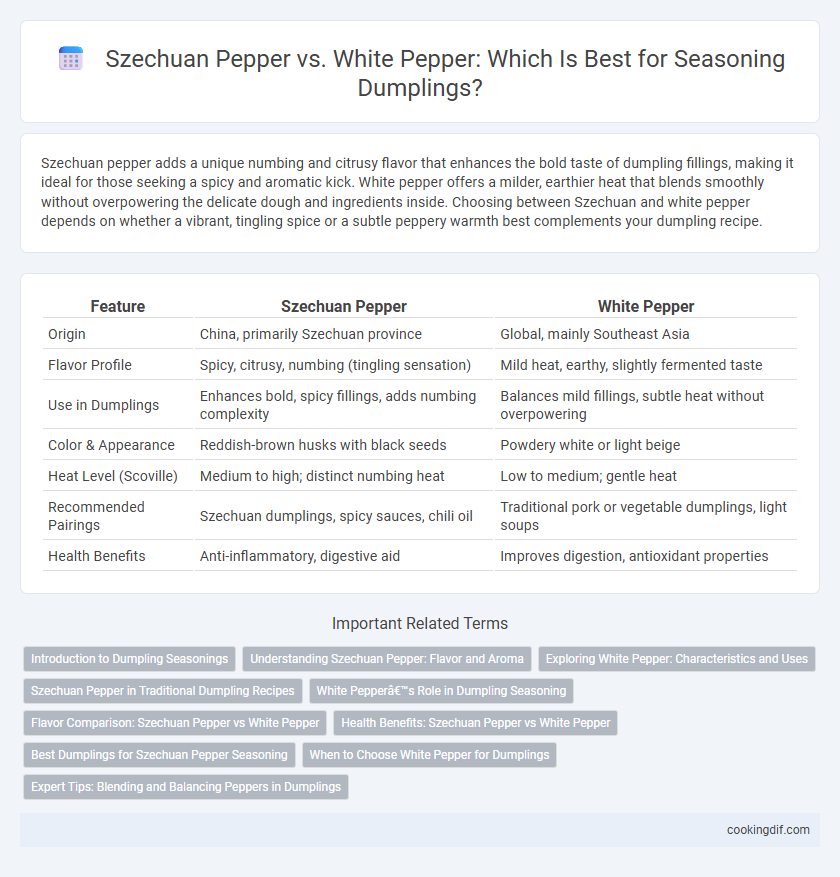Szechuan pepper adds a unique numbing and citrusy flavor that enhances the bold taste of dumpling fillings, making it ideal for those seeking a spicy and aromatic kick. White pepper offers a milder, earthier heat that blends smoothly without overpowering the delicate dough and ingredients inside. Choosing between Szechuan and white pepper depends on whether a vibrant, tingling spice or a subtle peppery warmth best complements your dumpling recipe.
Table of Comparison
| Feature | Szechuan Pepper | White Pepper |
|---|---|---|
| Origin | China, primarily Szechuan province | Global, mainly Southeast Asia |
| Flavor Profile | Spicy, citrusy, numbing (tingling sensation) | Mild heat, earthy, slightly fermented taste |
| Use in Dumplings | Enhances bold, spicy fillings, adds numbing complexity | Balances mild fillings, subtle heat without overpowering |
| Color & Appearance | Reddish-brown husks with black seeds | Powdery white or light beige |
| Heat Level (Scoville) | Medium to high; distinct numbing heat | Low to medium; gentle heat |
| Recommended Pairings | Szechuan dumplings, spicy sauces, chili oil | Traditional pork or vegetable dumplings, light soups |
| Health Benefits | Anti-inflammatory, digestive aid | Improves digestion, antioxidant properties |
Introduction to Dumpling Seasonings
Szechuan pepper offers a distinctive numbing and citrusy flavor that enhances dumplings with a bold, spicy kick, making it ideal for those craving authentic Szechuan cuisine. White pepper delivers a milder, earthy heat with subtle floral notes, complementing the delicate dough and fillings without overpowering them. Both seasonings play crucial roles in dumpling recipes, balancing heat and aroma to elevate the overall taste profile.
Understanding Szechuan Pepper: Flavor and Aroma
Szechuan pepper delivers a unique numbing sensation combined with citrusy, slightly floral notes that enhance dumpling seasoning by adding complexity and depth. Unlike white pepper, which provides a straightforward mild heat and earthy warmth, Szechuan pepper's aromatic profile includes tingling liveliness that elevates the overall flavor experience. Integrating Szechuan pepper into dumpling recipes balances spicy and fragrant elements, making it ideal for authentic Szechuan-style dishes.
Exploring White Pepper: Characteristics and Uses
White pepper offers a milder, earthier flavor compared to the bold, numbing heat of Szechuan pepper, making it ideal for seasoning delicate dumpling fillings without overpowering other ingredients. Its subtle spiciness and slightly fermented aroma blend seamlessly with ingredients like pork, chicken, or vegetables, enhancing overall flavor complexity. Commonly used in Chinese cuisine, white pepper complements broths and dipping sauces, providing a balanced heat that accentuates dumpling dishes without the tongue-tingling sensation associated with Szechuan pepper.
Szechuan Pepper in Traditional Dumpling Recipes
Szechuan pepper is a key ingredient in traditional dumpling recipes, offering a unique numbing spiciness that enhances the overall flavor profile. Unlike white pepper, which provides a straightforward heat, Szechuan pepper imparts a citrusy, tongue-tingling sensation that complements the savory fillings. This distinctive seasoning creates a balanced, authentic taste that defines many classic Szechuan-style dumplings.
White Pepper’s Role in Dumpling Seasoning
White pepper plays a crucial role in dumpling seasoning by imparting a mild heat and subtle earthiness that complements the delicate flavors of the filling. Unlike Szechuan pepper, which delivers a distinctive numbing sensation and citrusy notes, white pepper enhances the savory profile without overpowering other ingredients. Its fine texture ensures an even distribution in the dough and filling, making it a staple spice for balanced, aromatic dumplings.
Flavor Comparison: Szechuan Pepper vs White Pepper
Szechuan pepper offers a unique citrusy and numbing sensation that enhances dumpling flavors with a bold, aromatic punch, contrasting with white pepper's subtle, earthy heat and slightly fermented taste. The tingling effect of Szechuan pepper complements rich meat fillings, while white pepper provides a gentle warmth ideal for delicate broth-based dumplings. Choosing between Szechuan and white pepper significantly influences the overall flavor profile, balancing intensity and complexity in dumpling seasoning.
Health Benefits: Szechuan Pepper vs White Pepper
Szechuan pepper contains hydroxy-alpha-sanshool, which may improve blood circulation and provide anti-inflammatory properties, supporting cardiovascular health. White pepper is rich in piperine, known to enhance digestion and possess antioxidant effects that can reduce oxidative stress. Both peppers contribute unique health benefits, with Szechuan pepper favoring inflammation reduction and circulation, while white pepper promotes digestive health and antioxidant protection.
Best Dumplings for Szechuan Pepper Seasoning
Szechuan pepper is renowned for its unique numbing and citrusy flavor, making it an exceptional seasoning for spicy Szechuan-style dumplings. Its distinct aroma enhances the boldness of pork or beef dumplings, providing a balanced heat that contrasts with the savory filling. White pepper, milder and earthier, is better suited for delicate or steamed dumplings where subtle heat is preferred, whereas Szechuan pepper elevates dumplings with robust and complex seasoning profiles.
When to Choose White Pepper for Dumplings
White pepper is preferred for seasoning dumplings when a subtle heat and mild peppery aroma are desired without overpowering the other ingredients. It blends seamlessly into delicate dumpling fillings, preserving the overall flavor balance and enhancing the umami experience. White pepper's less pungent profile is ideal for steamed or boiled dumplings where a gentle spiciness complements rather than dominates.
Expert Tips: Blending and Balancing Peppers in Dumplings
Szechuan pepper adds a unique numbing citrusy heat that enhances the dumpling's filling, while white pepper delivers a milder, earthy spiciness that complements the dough's subtle flavor. Expert tips recommend blending these peppers in precise ratios, typically one part Szechuan to two parts white pepper, to balance boldness with a smooth finish. Proper seasoning ensures the dumpling's layers flavor harmoniously, elevating both texture and aroma.
Szechuan pepper vs White pepper for seasoning Infographic

 cookingdif.com
cookingdif.com